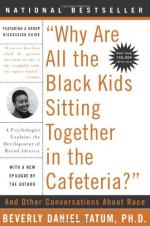
|
| Name: _________________________ | Period: ___________________ |
This test consists of 15 multiple choice questions and 5 short answer questions.
Multiple Choice Questions
1. What is a way of conceptualizing racial inequalities that focuses as much on the advantages that white people accrue from society as on the disadvantages that people of color experience?
(a) Black oppression.
(b) Racism.
(c) White privelege.
(d) Otherness.
2. According to the author in Part II, Understanding Blackness in a White Context, Chapter 4, Identity Development in Adolescence, the process of Nigrescence leads to the formation of an oppositional identity that produces what?
(a) Self-segregation.
(b) Internalization.
(c) Alienation.
(d) Diffusion.
3. What refers to an affective state of consciousness in which joy, sorrow, fear, hate, or the like, is experienced, as distinguished from cognitive and volitional states of consciousness?
(a) Immersion.
(b) Internalization.
(c) Emotion.
(d) Hostility.
4. In Part I, A Definition of Terms, Chapter 2, The Complexity of Identity, Tatum writes that she sometimes runs an experiment in classes with young students to write down as many responses to an "I am ____" question as they can in what period of time?
(a) 60 seconds.
(b) 3 minutes.
(c) 45 seconds.
(d) 10 seconds.
5. Erik Erikson is most famous for having coined what phrase?
(a) "Race identity."
(b) "Inter-racial."
(c) "Identity crisis."
(d) "Racial bias."
6. What refers to a suspension of activity?
(a) Moratorium.
(b) Conflation.
(c) Diffusion.
(d) Adaptation.
7. Beverly Daniel Tatum earned her PhD in clinical psychology from which university?
(a) The University of Michigan.
(b) The CUNY Graduate Center.
(c) Boston College.
(d) Hartford Seminary.
8. In Part II, Understanding Blackness in a White Context, Chapter 5, Racial Identity in Adulthood, Tatum reports that she did not sit at the Black table in her cafeteria for what reason?
(a) The Black students were academically superior.
(b) The janitors didn't clean the tables.
(c) There were too few Black students with which to do so.
(d) It was too crowded.
9. What refers to a personally offensive act or word; deliberate act or display of disrespect?
(a) Euthanize.
(b) Affront.
(c) Virtue.
(d) Default.
10. The author writes in Part II, Understanding Blackness in a White Context, Chapter 4, Identity Development in Adolescence that the blacks who remain academically successful need a strategy to be accepted by whites, so they act in what manner?
(a) Goal-oriented.
(b) Raceless.
(c) Like white people.
(d) Like asian people.
11. What is the third stage of William E. Cross, Jr.'s theory of Nigrescence?
(a) Internalization-commitment.
(b) Encounter.
(c) Immersion/emersion.
(d) Internalization.
12. What is the second stage of William E. Cross, Jr.'s theory of Nigrescence?
(a) Encounter.
(b) Pre-encounter.
(c) Immersion
(d) Internalization.
13. Who signed the Civil Rights Act of 1968?
(a) Lyndon B. Johnson.
(b) James K. Polk.
(c) Ulysses S. Grant.
(d) Chester A. Arthur.
14. What is the first of Erik Erikson's life-stage virtues which is comprised of the first year of infancy?
(a) Will.
(b) Confidence.
(c) Hope.
(d) Fidelity.
15. What groups benefit from systems of racism (and other isms), according to the author?
(a) Dominant groups.
(b) Political groups.
(c) Radical groups.
(d) Fringe groups.
Short Answer Questions
1. Beverly Daniel Tatum received her B.A. in psychology from which institution?
2. What refers to a distressing emotion aroused by impending danger, evil, pain, etc., whether the threat is real or imagined?
3. Tatum writes that much of the attraction of the Nation of Islam to black men is that it offers them what?
4. What is the third of Erik Erikson's life-stage virtues which is comprised of the ages from three to six?
5. What university did Tatum attend and describe as a black school that had recently gone co-ed in Part II, Understanding Blackness in a White Context, Chapter 5, Racial Identity in Adulthood?
|
This section contains 583 words (approx. 2 pages at 300 words per page) |

|




